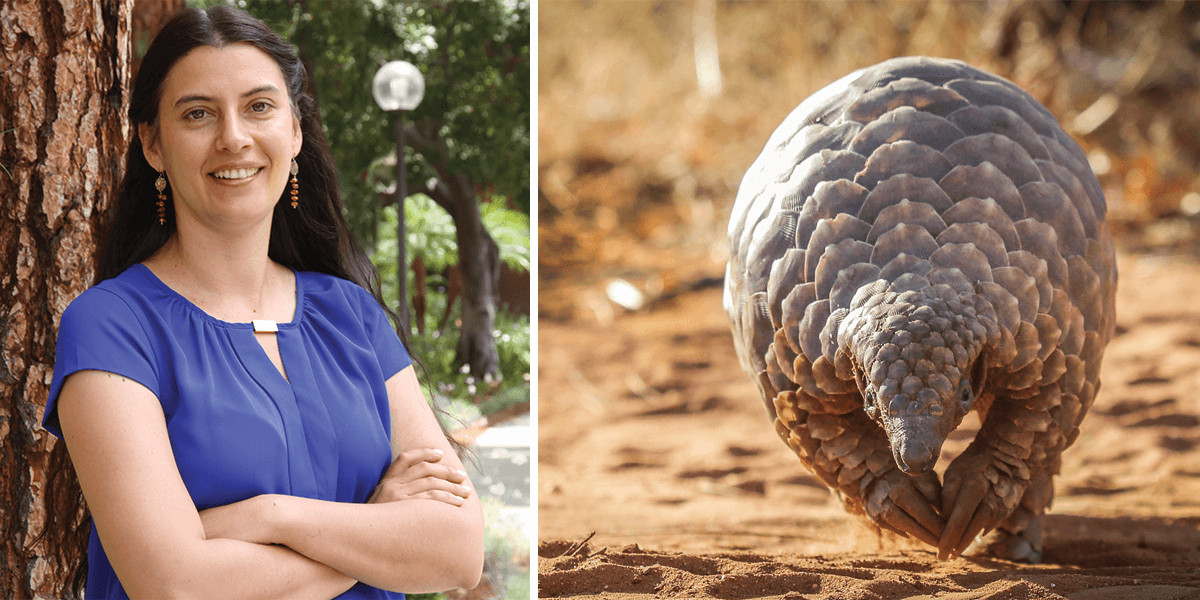
Bistra Dilkina will unite diverse data sources on pangolin populations and crime, and design innovative artificial intelligence tools and data science platforms. Photo/Caitlin Dawson/iStock
Bistra Dilkina, an associate professor of computer science and industrial and systems engineering at USC, joins a team of researchers and conservationists embarking on a bold initiative to save the world’s most trafficked wild mammal — the pangolin.
With core-funding support from the Paul G. Allen Family Foundation, Operation Pangolin has launched in Cameroon and Gabon with plans to expand into Nigeria soon. Among the least studied animals in the world, little is known about the natural history or ecology of the world’s eight pangolin species.
Even less is known of their role in a significant criminal economy where trafficked pangolins and the illegal sale of their scales and meat often go undetected. Operation Pangolin will generate much-needed data to inform conservation strategies in Central Africa, with global implications for the illicit wildlife trade.
The team will then help implement the identified strategies, including wildlife crime prevention, with the hope of expanding their efforts into Asia, the only other continent with native pangolin populations.
“I look forward to drawing on my past decade of research in developing computer science solutions for biodiversity conservation to build new technology tools to address pangolin poaching and trafficking,” said Dilkina.
Dilkina, who co-directs USC’s Center for AI in Society, will lead the data coalescence and artificial intelligence aspects of the project. This will involve uniting diverse data sources on pangolin populations and crime, and designing innovative artificial intelligence tools and data science platforms. The goal is to distill new insights about what drives trafficking behavior and to improve predictions and decision-making for wildlife trafficking prevention.
“This work will enable us to better understand threats to wildlife and make inferences to stop biodiversity loss.” Bistra Dilkina
“In partnership with local communities, we will unite diverse streams of data on pangolin populations and on wildlife crime, and design innovative AI tools and data science platforms to identify patterns and trends in illicit wildlife trafficking,” said Dilkina. “This work will enable us to better understand threats to wildlife and make inferences to stop biodiversity loss. I’m thrilled to work with such an amazing interdisciplinary team to help save the world’s most trafficked mammal.”
The collaborative research team also includes:
- Matthew H. Shirley from Florida International University, focusing on ecological monitoring;
- Alasdair Davies from the Arribada Initiative, focusing on technological innovation;
- Dan Challender from the University of Oxford, focusing on trade and policy;
- Meredith Gore from the University of Maryland, focusing on conservation criminology.
“Without urgent conservation action at a global scale, all eight species of pangolins face extinction,” said Shirley, project lead for Operation Pangolin. “Operation Pangolin is a chance to alter the conservation landscape for pangolins and other wildlife threatened by illicit human behavior.”
The researchers are joining forces with Carla Louise Mousset Moumbolou and her team from the Agence Nationale des Parcs Nationaux (Gabon’s national parks agency) to lead implementation efforts in Gabon and Andrew Fowler and his team from ZSL (Zoological Society of London) to lead implementation in Cameroon. The project is supported by the IUCN Pangolin Specialist Group, a global network of 189 pangolin technical specialists.
The team is developing toolkits for pangolin monitoring and data collection, a critical first step to prevent extinction of these evolutionarily distinct and imperiled mammals. The toolkits will incorporate the latest advancements in hardware and software, while using locally accessible and low-cost technological components.
Data-driven approaches
One of the major challenges the team will face is the scarcity of available data on pangolin poaching and trafficking, and pangolin ecology and conservation in general.
“There’s much less data about wildlife trafficking than about drugs or human trafficking, and one of the reasons is that it’s less criminalized,” said Dilkina. “This can make the AI job very hard because the data is very sparse and noisy.”
As such, Dilkina and the team will first gather existing and new data from numerous disparate sources, including monitoring and poaching records; streams of data from audio, camera and motion sensors deployed by the Operation Pangolin team; trade routes and air transportation network data; criminal records of previous pangolin product seizures; and geographic information system (GIS) data about roads, rivers, transportation hubs, markets and settlements.
Dilkina will lead the creation of a framework that allows these different layers of data to “interact” with each other. Then, using this data, she will create AI modeling tools to infer the trafficking network and to predict potential paths that poachers may take.
“We hope this will provide a better understanding of what trafficking networks look like and the key characteristics that influence the traffickers’ choices,” said Dilkina. “We want to understand whether the likely trafficking routes have choke points, or weak points, where interventions will make a big difference.”
Eventually, Dilkina aims to create an interface that allows domain experts, such as conservationists, to explore the data and conduct “what-if” analyses.
“The goal is to put all this data together — to know where the species are, where they’re being harvested, where they’re being trafficked, and where they’re being demanded in the international market for consumption,” said Dilkina.
“It’s really exciting, because it’s working directly on one of the most pressing specific challenges, the pangolin, but also some of the most pressing challenges overall in conservation, such as how do we think about stopping illegal wildlife trafficking with data-driven approaches.”
A blueprint for conservationists
The researchers will work with local conservation stakeholders, including indigenous peoples, local communities and government agencies to deploy monitoring programs, implement conservation interventions and develop predictive tools for addressing wildlife crime.
“Accurate, actionable data is the foundation of effective conservation efforts,” said Gabe Miller, director of technology on behalf of the Paul G. Allen Family Foundation. “Operation Pangolin will provide a blueprint for how conservationists can turn data into solutions that address important issues like wildlife trafficking and the biodiversity crisis head-on.”
Both IUCN and the Parties to the Convention on International Trade in Endangered Species of Wild Fauna and Flora (CITES) agree that the development of pangolin-specific monitoring methods linked to anti-trafficking efforts is the highest conservation priority for these mammals.
Throughout history, pangolins have been sustainably used for food and medicine, but overexploitation has exploded in recent decades resulting in threatened status for all eight species. The main threat, both in Asia and increasingly in Africa, is poaching for international wildlife trafficking.
Enough pangolin scales have been seized in the past decade to account for at least 1 million pangolins, yet little is known of the trafficking supply chains. This number does not account for the pangolins that are removed undetected from the wild to fuel this illegal enterprise. At least 250,000 are estimated to be taken from African and Asian forests every year for consumers in China, Vietnam, and even western Europe and the United States.
The $4 million grant from the Paul G. Allen Family Foundation supports the current launch of the project in Central Africa. The research team is concurrently raising funds in an effort to expand the project to Asia by 2027.
Published on February 16th, 2023
Last updated on February 17th, 2023













